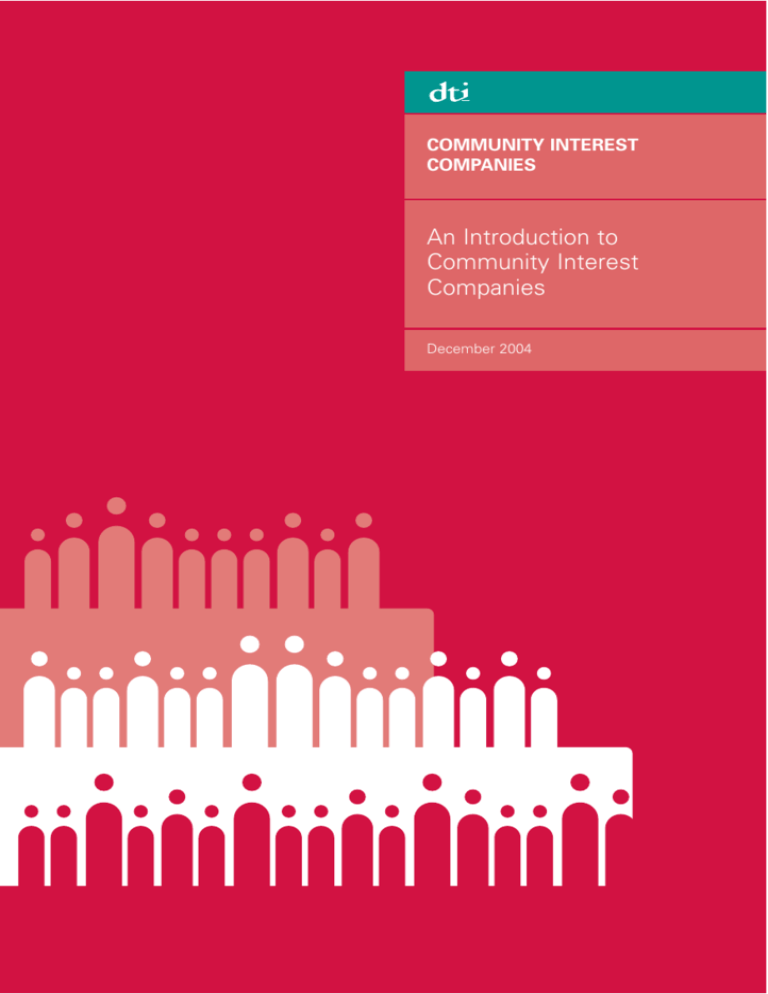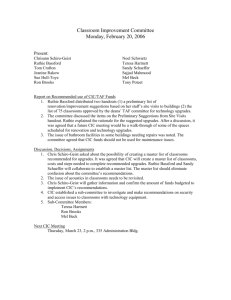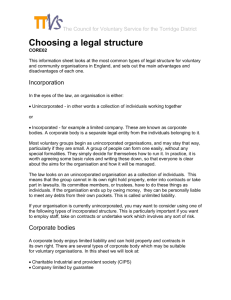CIC Leaflet - UK Government Web Archive
advertisement

COMMUNITY INTEREST COMPANIES An Introduction to Community Interest Companies December 2004 The DTI drives our ambition of ‘prosperity for all’ by working to create the best environment for business success in the UK. We help people and companies become more productive by promoting enterprise, innovation and creativity. We champion UK business at home and abroad. We invest heavily in world-class science and technology. We protect the rights of working people and consumers. And we stand up for fair and open markets in the UK, Europe and the world. Community Interest Companies An introduction to Community Interest Companies The CIC Project Team DTI Bay 232 Elizabeth House 39 York Road London SE1 7LJ Introduction The Government have created Community Interest Companies (CICs) as a new type of company for those wishing to establish social enterprises. Social enterprises, businesses that trade with a social purpose, are a fast growing sector of our society. They are already active in a wide range of areas, from childcare and social housing to renewable energy and fair trade. Some incorporate as companies, while others take the form of industrial and provident societies (the legal form for co-operatives). Others in the sector, and the voluntary and community sector more widely, may choose less formal legal structures for example with assets held on their behalf by trustees. The CIC will be a valuable addition to existing forms and particularly suitable for those who wish to work within the relative freedom of the familiar limited company framework without either the private profit motive or charity status. 02 An introduction to Community Interest Companies It is planned that you will be able to register CICs from the summer of 2005, but this depends on the appropriate parts of the Companies (Audit, Investigations and Community Enterprise) Act 2004 and Regulations being brought into force, a new independent Regulator being appointed and the Regulator’s office opening for business. The CIC Project Team is working towards achieving this; a consultation document on draft CIC Regulations was issued on 11 October 2004 [see page 12 for details]. An introduction to Community Interest Companies 03 About this fact sheet In the meantime we are publishing this series of fact sheets to make people more aware of CICs, help them consider whether a CIC may suit their needs and allow them to register their interest. This will also assist the Regulator in planning the office to provide the best possible service. We expect that when appointed the Regulator will replace these fact sheets by guidance material (including examples of essential documents such as the memorandum and articles of association). Your feedback on these fact sheets will help in this work. 04 An introduction to Community Interest Companies This first fact sheet gives an overview; in the coming months we will issue further fact sheets giving more detailed information on subjects such as: , Who is eligible to become a CIC , The Community Interest Test and other requirements , The CIC constitution and Memorandum and Articles of Association , The Asset Lock , How the Dividend Cap will work , How to apply to become a CIC , The annual CIC Report , Directors’ Duties , Investment in CICs , The Shareholders’ Role , The Regulator’s Role , Appeals against decisions by the Regulator , The Appeal Officer , Complaints about the conduct of CICs, their directors etc , Compliance and enforcement An introduction to Community Interest Companies 05 About CICs An organisation wishing to be a CIC can choose one of three company forms: private company limited by shares, limited by guarantee or public limited company. To ensure that they use their assets and profits for the community interest CICs will have some special, additional features: , They will be restricted from distributing profits and assets to their members. This is known as an ‘asset lock’ – a transparent and entrenched way of ensuring that assets are used to benefit the community. , To register as a CIC a company must: i) adopt a suitable constitution and ii) satisfy (in the opinion of the Regulator) a community interest test, confirming that it will pursue purposes beneficial to the community and will not serve an unduly restricted group of beneficiaries. The test is whether a reasonable person could consider the CIC’s activities to benefit the community. 06 An introduction to Community Interest Companies , All CICs must produce an annual community interest report, which will be delivered with their accounts to Companies House and placed on the public record. The report must record what the CIC has done to pursue the community interest and involve its stakeholders during the year. This will ensure that the community served by the CIC will have easy access to key information on its activities. , In order to raise investment, CICs limited by shares will have the option of issuing shares that pay a dividend to investors. The dividend payable on these shares will be subject to a cap, set by the Regulator (after consultation), in order to protect the asset lock. , Applications for registration of a company as a CIC will be made to the Registrar of Companies in the usual way, but before the company can be incorporated the application will be referred to the Regulator who will consider whether the company is eligible for CIC status. An introduction to Community Interest Companies 07 , The Regulator will also consider other aspects of a CIC’s constitution such as proposed changes in a CIC’s objects and the conduct of individual CICs. The Regulator will also provide general guidance to CICs and stakeholders, and maintain public confidence in CICs by ensuring that they comply with the law. , The Regulator will charge fees for some functions; these are expected to be at a similar rate to fees charged by Companies House. There may be some additional costs attached to the formation of CICs but the level of such costs and the fees should not be a significant factor in deciding whether a CIC is the right vehicle for a particular enterprise. 08 An introduction to Community Interest Companies Will a CIC be right for your organisation? The decision whether the CIC form is suitable for your organisation must be a matter for you and your professional advisers. The website www.businesslink.gov.uk has guidance on choosing the right legal structure for your business but the following points may be of assistance: , An organisation cannot be both a CIC and a charity. CICs will be more lightly regulated than charities but will not have the benefits of charitable status, even if their objects are entirely charitable in nature. , Charities, and all other (non political) organisations, will be able to establish CICs as subsidiaries. , CIC’s will not enjoy any special tax status as such. They will generally be in the same position as any other organisation in obtaining any tax concessions or grants otherwise available, for example due to their type of activity or location. You should make sure you understand the tax consequences for your organisation of becoming a CIC. This is particularly so for organisations with wholly charitable purposes where An introduction to Community Interest Companies 09 the benefits of lighter CIC regulation may well be outweighed by the tax benefits of being a charity. If in doubt, get professional advice. , There will be the option of setting up a CIC limited by shares, which in order to encourage investment, will have the ability to pay a capped dividend to some shareholders. If you do not want to pay any returns you can adopt the form of a company limited by guarantee. , Over time the familiarity of banks and other commercial sources of finance with the company format should make their dealings with CICs easier. , Stakeholders will have a clear idea of how a CIC has performed as it will make an annual community interest company report detailing what it has done and how this has benefited the community, what directors’ salaries and dividends have been paid and to what extent it has involved its community in its activities. 10 An introduction to Community Interest Companies Summary A CIC may well be the vehicle for your social enterprise if: , You want to incorporate with limited liability , You want to be a company because it is a familiar legal form with the flexibility to tailor it to your own organisational structure, membership and governance , You want it to be clear to your members, financial backers, customers and others you deal with that you will work for the benefit of the community rather than private gain , You want to be sure that, if the organisation ceases to be a CIC, the remaining assets will be preserved for the community rather than distributed to members , You do not want charitable status e.g. because it is not appropriate to your planned activities or the financial benefits of being a charity will not be material An introduction to Community Interest Companies 11 Where can I get further information on CICs? , Register your interest on the reply form at the end of this fact sheet , Visit our web site www.dti.gov.uk/cics which contains background information, and links to consultation and working papers issued before introduction of legislation, the consultation document and Act below and other Social Enterprise related sites. , Companies (Audit, Investigations and Community Enterprise) Act 2004 and explanatory notes , Consultation Document on the draft Community Company Regulations 2004 issued on 11 October 2004 (closing date for comments 4 January 2005) , We are also available to deal with questions on CIC policy, progress of the legislation and other general issues relating to CICs. You can contact us at Bay 232 Elizabeth House 39 York Road London SE1 7LJ Phone 020 7215 6947 E-mail CICS@dti.gsi.gov.uk , For general information on company registration and similar topics visit the Companies House web site www.companieshouse.gov.uk 12 An introduction to Community Interest Companies 2 Printed in the UK on recycled paper with a minimum HMSO score of 75. First published December 2004. Department of Trade and Industry. © Crown Copyright. http://www.dti.gov.uk/ DTI/Pub 7655/1.5k/12/04/NP. URN 04/1983








